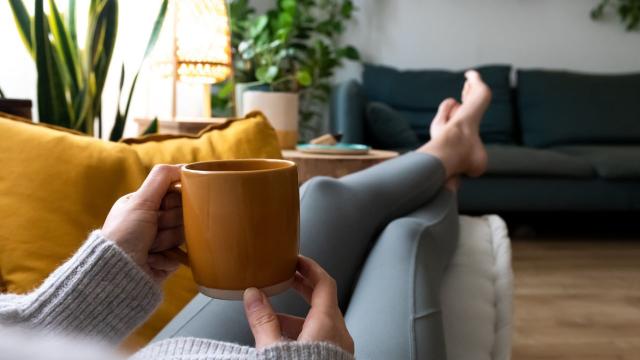The tea section of the grocery store sometimes feels more like a pharmacy. Boxes boast health claims, and even if you choose a plain old green tea, you know in the back of your mind that it’s supposed to be good for your health somehow…right? And then there are the teas being marketed on social media for slimming your belly or energising your day. Can tea really do all of that?
These products are all different, so let’s dig into each category. Like other home remedies, you probably can’t expect much of most teas, but some have known or potential benefits — and potential downsides.
Herbal tea
Sticklers will say that herbal tea isn’t really tea, since that word refers to a drink made from leaves of the tea plant. (They would call a non-tea-leaf drink a tisane.) An herbal tea can refer to pretty much any plant that is steeped in hot water to make a beverage. For example, chamomile flowers are used to make chamomile tea. Most herbs used this way do not contain caffeine, so herbal teas are almost always caffeine-free.
Each plant used in an herbal tea has its own potential benefits and downsides, so if you’re looking for specific benefits from an herbal tea, it’s worth doing some research into the particular tea — not just what it’s “used for,” but whether it works and whether it has any known side effects or if it may interact with medications you’re taking.
A 2019 review on the health benefits of herbal teas found that there were surprisingly few studies that studied their health benefits rigorously. There were a few studies on topics like maternal health (including lactation), hypertension, diabetes, and mental health. But the authors only found one study looking at a tea’s effects on cold or flu, and no studies on turmeric tea or fruit or berry teas, despite their raw ingredients being studied in other formats (for example, turmeric extracts).
They also found that most studies on herbal tea did not report adverse effects at all. Herbal tea preparations may not be likely to cause serious problems, but that doesn’t mean the possibility should be ignored. The Poison Control Centre notes that ginseng, foxglove, and arnica teas have been associated with health problems. They caution not to make your own herbal teas and never to give herbal tea to infants.
Ultimately this lack of data leaves herbal tea drinkers guessing as to what teas to use, and in what dosages, without necessarily knowing whether they will work at all. All herbal medicine has an issue with imprecise dosing, tea included: The active ingredient in a plant may be more concentrated in some plant parts than others (the flower versus the leaf, for example) and it may vary based on where the plant was grown and when in the season it was harvested.
Pharmaceuticals use consistent, predictable dosages, so that providers and patients have the best chance of getting the intended effect. Herbal preparations, on the other hand, are more of a guess. Teas add another layer of unpredictability: How much of the active ingredients actually make it into the tea you drink? There’s no way to know.
Trendy tea beverages
Next up, let’s look at the tea-based or tea-like beverages that are aggressively marketed online by influencers and multi-level marketing distributors.
One category of tea is marketed as helping people lose weight or sculpt their bodies. These are sometimes regular teas with extra marketing, like this Booty Tea that contains Pu-Erh and green tea (both are made from the tea plant) plus ginger.
But often, these teas are made with laxatives. Flatbelly Tea contains senna, a laxative, and dandelion leaf, which is a diuretic. Laxatives and diuretics can cause you to lose water weight, so you’ll see the numbers on the scale temporarily go down. But they don’t cause fat loss, which is what you’re probably looking for when you buy a weight-loss tea. Excessive use of laxatives for weight loss can cause dehydration, electrolyte imbalance, and occasionally more serious side effects.
Another category of beverage is “loaded” or “boosted” tea. Often sold by MLM companies like Herbalife, these are marketed for their health benefits but are more similar to energy drinks than to the herbal or green teas mentioned above. They may be low-calorie or they may contain corn syrup; some have herbal stimulants or vitamins like niacin (which gives a skin-tingling sensation in high doses). There may or may not be tea in the mix. An article in U.S. Pharmacist warns that the caffeine content is high enough to be potentially dangerous for children and teens.
Green tea and other “true” teas
Tea made from the tea plant (Camellia sinensis) includes green tea, black tea, white tea, and oolong. These teas have a long history, are consumed all over the world, and are the subject of far more research than herbal teas.
The benefits and downsides are better understood, but there still isn’t a ton of conclusive research about them. For example, its antioxidants “may” help stave off various diseases, and several studies have found that tea drinkers tend to be healthier than people who don’t routinely drink tea. These studies are observational, though. Tea drinkers may have differed from their non-tea-drinking peers in other ways that affected the results.
Tea also contains caffeine, which has known effects on alertness and focus (potentially good) and can make it harder to get to sleep (potentially bad). The National Institutes of Health report that studies have shown inconclusive results on cancer, possibly beneficial results for heart disease, and have not been able to find a benefit for weight loss. “It’s uncertain whether green tea is helpful for other conditions,” they write.

Leave a Reply
You must be logged in to post a comment.